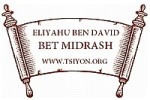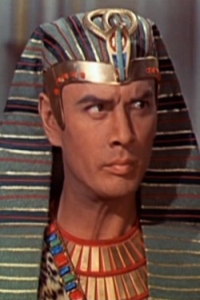DID
THE EXODUS HAPPEN? AN ANSWER TO THE SCEPTICS
By:
Dr. David Lewis
A new wave of scholars is now dogmatically
declaring that the Exodus never took place. They
insist it’s just a myth concocted centuries later in
the time of Josiah to justify the existence of a
Jewish state. Some of these new sceptics, such as
Zeev Hertzog and Israel I Finkelstein of Tel Aviv
University, are Jewish themselves!
The implications of their teaching are profound.
They insist that, historically, there really is no
such thing as a Jewish or Israelite people descended
from Abraham, Isaac, and Jacob. There never was an
Abraham, Isaac, or Jacob. Moses was a myth, and
never wrote the first five books of the Bible. The
so-called Israelites are just Canaanites that
emerged in Palestine, were joined by a few nomads,
and concocted a new religion.
Denial of the Exodus and the reality of the Biblical
account is nothing new. Neither are these arguments.
The sceptics have been around for over 200 years,
and much of their teaching has been the accepted
wisdom in universities for a long time. The theories
are now being recycled because of a lot of new
archaeological evidence that Professor Finkelstein
and others have uncovered. This evidence, it is
claimed, provides no evidence for the Exodus or the
Bible.
Looking in the Right Place at the Wrong Time
Are the sceptics right? They are looking at the
right evidence, but at the wrong time. Dating in the
history of Egypt and Palestine is based on a couple
of assumptions that professors have handed down over
the decades. First, they assume the Exodus took
place, not when the Bible says it did, around
1450-1447 BC but around 1300 BC. The Bible says the
Hebrews built the city of Ramesses and that existed
around the time of Ramses II who is dated around
1290. There is no evidence of Hebrews or an Exodus
at that time.
What
if, however, the Hebrews built the city of Avaris,
which existed before the city of Ramesses? Also,
what if the Egyptian chronology itself has been
wrongly focused? At the very time the historical
establishment was more and more rejecting the
Biblical record, a handful of archaeologists were
questioning the accepted wisdom. In 1991 a group led
by Peter James published a book called Centuries
of Darkness. Four years later British
archaeologist David Rohl published A Test of Time,
marketed in America as Pharaohs and Kings.
Both of these books argue, that the traditional
dating of much of ancient history before 1000 BC in
most history books is flawed.
Both James and Rohl did not start out with an
agenda of trying to prove the Bible. They just went
to the Egyptian tombs and monuments and concluded
that several of the later dynasties ruled side by
side. This meant that earlier dynasties were placed
anywhere from one hundred to three hundred years
further back than they should have been. The three
hundred year ‘Dark Age’ which historians describe in
Greece, Phoenicia, and other places, shrinks and
even disappears.
Move the Timeline and Things Start to Fit
The Pharaoh Shishak who invaded Jerusalem has
been identified with Soshenk. But Soshenk never
attacked Jerusalem but northern Israel! Another
Pharaoh did attack Jerusalem. ..the famous Rameses
II. In Egyptian he is Ra Me Shi Sha, the Shishak
being a Hebrew nickname for ‘The Destroyer’. Rohl
concluded that Shishak was Rameses, that the
splendid late Canaanite period was the time of
Solomon, that the period of the El Amarna letters
was the time of Saul and David.
Discovery of Hebrew Names in Goshen ‘Before Moses, the Bible records that the Israelites
were enslaved by their Egyptian hosts (Exodus
1:8-14). In the Brooklyn Museum (p.276, fig. 310)
resides a papyrus scroll numbered Brooklyn 35:1446
which was acquired in the late 19th century by
Charles Wilbour. This dates to the reign of
Sobekhotep III, the predecessor of Neferhotep I and
so the pharaoh who reigned one generation before
Moses. This papyrus is a decree by the pharaoh for a
transfer of slaves. Of the 95 names of slaves
mentioned in the letter, 50% are Semitic in origin.
What is more, it lists the names of these slaves in
the original Semitic language and then adds the
Egyptian name each had been assigned, which is
something the Bible records the Egyptians as doing,
cf. Joseph’s name given to him by pharaoh (Genesis
41:45). Some of the Semitic names are biblical and
include:- Menahem, Issachar, Asher, and Shiprah (cf.
Exodus 1:15-21). That 50% of the names are Israelite means that there
must have been a very large group of them in the
Egyptian Delta at that time, corroborating the
testimony of Exodus 1:7 which alludes to how
numerous the Israelites became. The sceptics look
for Israel in the Egypt of the Nineteenth Dynasty
and remain sceptics, because the proof is in the
Egypt of the Thirteenth Dynasty.
Graves of Israelite Babies The site of Avaris
has been uncovered by the Austrian archaeologist
Manfred Bietak in the land of Goshen underneath that
of the city of Ramesses. It provides plenty of
proof, says Fulton, for Israel’s presence and
sufferings in Egypt: ‘The people who lived in Avaris were not Egyptian
but Asiatic Palestinian or Syrian. The finds there
included numerous pottery fragments of Palestinian
origin. Several factors about the graves were
particularly fascinating:- 65% of the burials were
of children under 18 months of age, the normal for
this period being 20-30%. Could this be due to the
killing of the male Israelite children by the
Egyptians, recorded in Exodus 1:22? A
disproportionately high number of adult women as
opposed to adult men are buried here, again pointing
to the slaughter of male Israelite babies. There are
large numbers of long-haired Asiatic sheep buried
which indicate these people to be shepherds. Large
numbers of weapons found in the male graves indicate
the warlike nature of the people.’
Early Moses as Egyptian General According to the Bible, Moses was born around 1527
BC, in the reign of Neferhotep I. A few fragments of
ancient records from a Jewish historian called
Artapanus were preserved by the Catholic historian
Eusebius. They say that the Pharaoh’s daughter at
the time Moses was born was called Merris. She
married the Pharaoh Khenephres, also called
Sobekhotep IV. ‘The Egyptians, under this sad oppression, betook
themselves to their oracles and prophecies; and when
God had given them this counsel, to make use of
Moses the Hebrew, and take his assistance, the king
commanded his daughter to produce him, that he might
be the general of their army ... So Moses ...
cheerfully undertook the business’ and defeated the
African invaders by marching through a
snake-infested region and taking them by surprise:
‘When he had therefore proceeded thus on his
journey, he came upon the Ethiopians before they
expected him; and, joining battle with them, he beat
them, and deprived them of the hopes they had of
success against the Egyptians, and went on in
overthrowing their cities, and indeed made a great
slaughter of these Ethiopians.’ Josephus was right. A monument in the British Museum
tells of Khanferre or Khenephres invading Sudan and
Ethiopia, the only Thirteenth Dynasty ruler to do
so. Remains of an Egyptian government building with
the Pharaoh’s statue has been found hundreds of
miles south of known Egyptian territory.
First-born Egyptian Graves - Followed by Exodus ‘The Tenth Plague to be sent on Egypt just before
the Exodus was the plague on the first-born,
recorded in Exodus 12:29,30. At the end of stratum
G/l at Tell ed-Daba or the ancient city of Avaris
(p.293), archaeologists found shallow burial pits
into which the victims of some terrible disaster had
been thrown. These death pits were not carefully
organized internments; the bodies were simply thrown
in on top of one another. Could these be the burial
pits of the first-born Egyptians? What is more,
immediately after this disaster, the remaining
population left Avaris en masse; this fits perfectly
with the Exodus of the Israelites following the
final terrible plague.’
Collapse of Egypt Reported Manetho, the Egyptian historian wrote how Egypt
collapsed in the reign of Dudimose: ‘Tutimaos: In his reign, for what cause I know not,
a blast of God smote us; and unexpectedly, from the
regions of the East, invaders of obscure race
marched in confidence of victory against our land
(Egypt). By main force they easily seized it without
striking a blow and having overpowered the rulers of
the land, they then burned our cities ruthlessly,
razed to the ground the temples of the gods and
treated all our natives with cruel hostility,
massacring some and leading into slavery the wives
and children of others.’ The invaders were the Amalekites Israel encountered
after leaving Egypt. They found Egypt, devastated by
Divine judgment an easy prey. ‘The continuing archaeological discoveries’ says
Fulton, ‘here in the ancient city of Avaris mirror
exactly the early Israelites revealed in the Old
Testament. For two centuries no evidence was found
for the Israelites when looking in the strata of the
19th Dynasty. Now that the chronologies have begun
to be amended and the sojourn in Egypt placed in the
12th and 13th Dynasties, we have a wealth of
archaeological evidence corroborating the Biblical
account.’
Rohl’s biggest discovery, though, was in finding
the evidence for the Exodus in the Thirteenth
Dynasty. His findings are summarized by John Fulton,
a supporter of David Rohl:
Moses or Mousos, meanwhile became a great general
who invaded Nubia and Ethiopia. Josephus,
Antiquities of the Jews, 2.10.1-2 tells the story.
The Ethiopians had invaded Egypt and had practically
overrun the country:
Sobekhotep IV/Khenephres was the Pharaoh of the
Oppression from whom Moses fled, about 1487 BC. The
forty years Moses spent in Midian were likely to
have been 1487-1447 BC. The Pharaoh of the Exodus
was Dudimose. Fulton records that the Austrians
found evidence both of God’s slaying of the
firstborn and the sudden departure of Israel from
Goshen:










